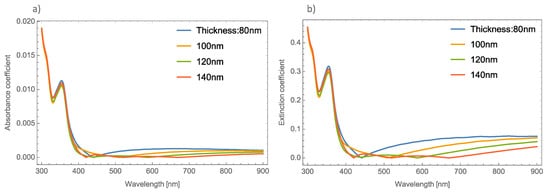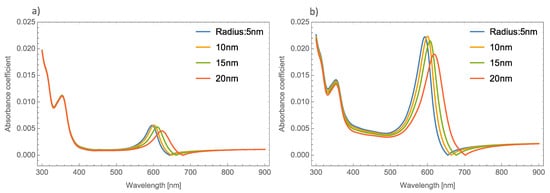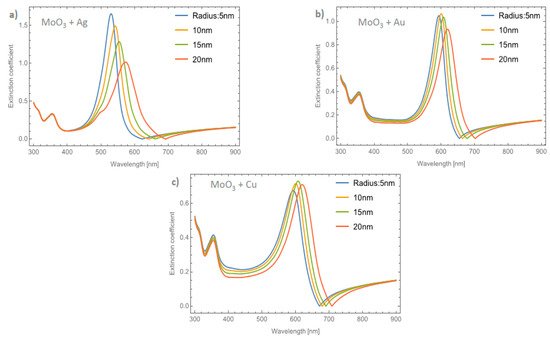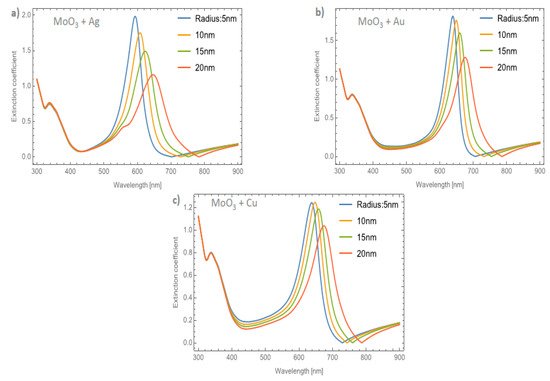Figure 98a–c displays the evolution of the
Qext of the
β-MoO
3 thin film as the embedded nanoparticles change at a volume filling fraction of 5%, for Ag, Au, and Cu respectively. From
Figure 98a for Ag doped MoO
3, the Δ
SPR-β value is 54 nm. Additionally, the redshift value of the extinction coefficient zero value is 83 nm and the obtained Δ
FWHM-β value for this case is 40.63 nm. As can been seen, the redshift value on the maximum resonant peak and the FWHM values of the peaks are strongly affected by the type and features of the nanoparticle. For the MoO
3 doped with Au nanoparticles, see
Figure 98b, the Δ
SPR-β and Δ
FWHM-β values are 37 and 24.01 nm, respectively. The change in the extinction coefficient zero values for this case is 81 nm.
Figure 98c displays the evolution of the
Qext as the nanoparticle radius changes at 5% of Cu NPs. The obtained values are Δ
SPR-β = 36 nm, the
Qext zero value shows a shift of 58 nm, and finally the Δ
FWHM-β = 17.72 nm. Notably, the behavior of the copper NPs that was presented in the
α-phase is not present in this case. For the
α-phase analysis there is an increase in the SPR signal intensity with the maximum depending on the doping nanoparticles used and the radius of the nanoparticles. In the
β-phase, the maximum of the SPR signal of the extinction coefficient partially decreases as the radius of the NPs increases. As can been observed, there is a maximum for the
Qext for nanoparticles of 10 nm radius. One of the most important things, in this case, is that the resonance peaks are similar to the cases of the gold nanoparticles embedded in the MoO
3 films but the widths of the spectra are greater than the gold NPs case. For the silver and gold NPs, the resonance peaks are narrower than the resonance peaks associated with the copper NPs. This demeanor in the extinction coefficient makes the copper NPs a good candidate for solar radiation absorber layer applications as in solar cells or solar condensers, instead of using silver or gold nanoparticles as dopants which are more expensive than copper nanoparticles. So, the range of the absorbance response of the MoO
3 thin films doped with Cu NPs could be greater than the Au or Ag doped MoO
3 thin films due to the wider extinction coefficient peaks covering more wavelengths of the spectrum.
Figure 98. The extinction coefficient of the MoO3 thin film doped with (a) Ag-NPs, (b) Au-NPs, and (c) Cu-NPs for a volume filling fraction of 5%. In all spectra, the thickness was fixed to a value of 120 nm, and different NPs radii are labeled.
Table 1 is presented where the resonant peak redshift values of the MoO
3 thin films doped with different types and characteristics of NPs, as labeled in the table, are reported. A demeanor that is easy to observe from this table is that the Ag nanoparticles present the highest Δ
SPR values compared to the Au and Cu nanoparticles. On the other hand, the MoO
3 thin films doped with Cu nanoparticles display the lowest changes in the Δ
SPR values in both phases of MoO
3. As a complement to the discussion and to
Table 1,
Table 2 is reported, where the change in the FWHM values can be seen for the different doping configurations of the MoO
3 thin film. From this table, it can be seen that the greatest broadening of the SPR signal occurs for Ag nanoparticles, as the radius of the nanoparticles increases and when the MoO
3 is in its beta phase. In the same way as was observed for the displacement of the maximum resonant peak, the FWHM values that demonstrated lower changes are the cases of MoO
3 thin films doped with Cu NPs.
Table 1. Centered resonant peak values at different phases of MoO
3 thin films doped with different nanoparticles at different volume filling fractions (
f).).
| |
|
Resonant Peak Redshift [nm] |
| |
|
α-Phase Radii NPs |
β-Phase Radii NPs |
| Nanoparticle |
f (%) |
5 |
10 |
15 |
20 |
ΔSPR-α |
| Nanoparticle |
f (%) |
5 |
10 |
15 |
20 |
Δ5 |
FWHM-10 |
15 |
20 |
ΔSPR-β |
| α |
|---|
| 5 |
10 |
15 |
20 |
Δ | FWHM- | β |
|---|
| Ag |
1 |
535 |
545 |
559 |
580 |
45 |
597 |
610 |
630 |
653 |
56 |
| Ag |
1 |
37.12 |
40.44 |
50.8 |
65.81 |
28.69 |
43.19 |
51.23 |
66.15 |
88.96 |
45.77 |
3 |
532 |
542 |
556 |
576 |
44 |
594 |
606 |
626 |
650 |
56 |
| 42.24 |
5 |
531 |
541 |
554 |
574 |
43 |
593 |
| 5 | 605 |
46.92 | 624 |
647 |
54 |
| 49.44 |
61.13 |
77.85 |
30.93 |
53.52 |
59.62 |
72.99 |
94.15 |
40.63 |
Au |
1 |
597 |
603 |
611 |
624 |
27 |
642 |
651 |
664 |
681 |
39 |
| Au |
1 |
38.92 |
38.78 |
42.94 |
51.51 |
12.59 |
37.38 |
38.57 |
45.26 |
61.09 |
23.71 |
3 |
596 |
601 |
609 |
622 |
26 |
640 |
648 |
661 |
678 |
38 |
| 3 |
42.57 |
42.65 |
46.92 |
56.77 |
14.20 |
40.33 |
42.21 |
48.68 |
64.09 |
23.76 |
5 |
594 |
| 5 | 600 |
608 |
620 |
26 |
639 |
648 |
660 |
676 |
37 |
| 45.61 |
45.86 |
49.89 |
60.37 |
14.76 |
43.96 |
46.26 |
52.98 |
67.97 |
24.01 |
Cu |
1 |
600 |
605 |
613 |
626 |
26 |
642 |
650 |
663 |
679 |
37 |
| Cu |
1 |
61.62 |
60.57 |
62.2 |
66.81 |
5.19 |
58.52 |
59.07 |
63.83 |
75.6 |
17.08 |
3 |
598 |
604 |
| 3 | 612 |
625 |
27 |
64.52640 |
648 |
661 |
677 |
37 |
| 63.99 |
66.1 |
5 |
597 |
602 |
610 |
623 |
26 |
639 |
647 |
659 |
675 |
36 |
Table 2. Full width at half maximum values of resonant peaks at different phases of MoO
3 thin films doped with different nanoparticles at different volume filling fractions (
f).).
| |
|
Full Width at Half Maximum (FWHM) [nm] |
| |
|
α-Phase Radii NPs |
β-Phase Radii NPs |
| 3 |
41.94 |
44.89 |
56.55 |
72.14 |
30.20 |
47.68 |
54.14 |
68.52 |
89.92 |
| 71.56 |
| 7.04 |
| 57.57 |
| 58.5 |
63.61 |
74.49 |
16.92 |
| 5 |
67.11 |
66.88 |
69.15 |
75.31 |
8.20 |
60.01 |
61.16 |
66.52 |
77.73 |
17.72 |








